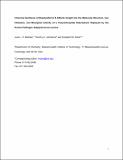Chemical Synthesis of Staphyloferrin B Affords Insight into the Molecular Structure, Iron Chelation, and Biological Activity of a Polycarboxylate Siderophore Deployed by the Human Pathogen
Author(s)
Madsen, Julie Lybaek Hoj; Johnstone, Timothy; Nolan, Elizabeth Marie
DownloadSB-JACS-SubmittedMS-050115.pdf (8.241Mb)
PUBLISHER_POLICY
Publisher Policy
Article is made available in accordance with the publisher's policy and may be subject to US copyright law. Please refer to the publisher's site for terms of use.
Terms of use
Metadata
Show full item recordAbstract
Staphyloferrin B (SB) is a citrate-based polycarboxylate siderophore produced and utilized by the human pathogen Staphylococcus aureus for acquiring iron when colonizing the vertebrate host. The first chemical synthesis of SB is reported, which enables further molecular and biological characterization and provides access to structural analogues of the siderophore. Under conditions of iron limitation, addition of synthetic SB to bacterial growth medium recovered the growth of the antibiotic resistant community isolate S. aureus USA300 JE2. Two structural analogues of SB, epiSB and SBimide, were also synthesized and employed to investigate how epimerization of the citric acid moiety or imide formation influence its function as a siderophore. Epimerization of the citric acid stereocenter perturbed the iron-binding properties and siderophore function of SB as evidenced by experimental and computational modeling studies. Although epiSB provided growth recovery to S. aureus USA300 JE2 cultured in iron-deficient medium, the effect was attenuated relative to that of SB. Moreover, SB more effectively sequestered the Fe(III) bound to human holo-transferrin, an iron source of S. aureus, than epiSB. SBimide is an imide analogous to the imide forms of other citric acid siderophores that are often observed when these molecules are isolated from natural sources. Here, SBimide is shown to be unstable, converting to native SB at physiological pH. SB is considered to be a virulence factor of S. aureus, a pathogen that poses a particular threat to public health because of the number of drug-resistant strains emerging in hospital and community settings. Iron acquisition by S. aureus is important for its ability to colonize the human host and cause disease, and new chemical insights into the structure and function of SB will inform the search for new therapeutic strategies for combating S. aureus infections.
Date issued
2015-06Department
Massachusetts Institute of Technology. Department of ChemistryJournal
Journal of the American Chemical Society
Publisher
American Chemical Society (ACS)
Citation
Madsen, Julie L. H., Timothy C. Johnstone, and Elizabeth M. Nolan. “ Chemical Synthesis of Staphyloferrin B Affords Insight into the Molecular Structure, Iron Chelation, and Biological Activity of a Polycarboxylate Siderophore Deployed by the Human Pathogen Staphylococcus Aureus .” Journal of the American Chemical Society 137, no. 28 (July 22, 2015): 9117-9127.
Version: Author's final manuscript
ISSN
0002-7863
1520-5126